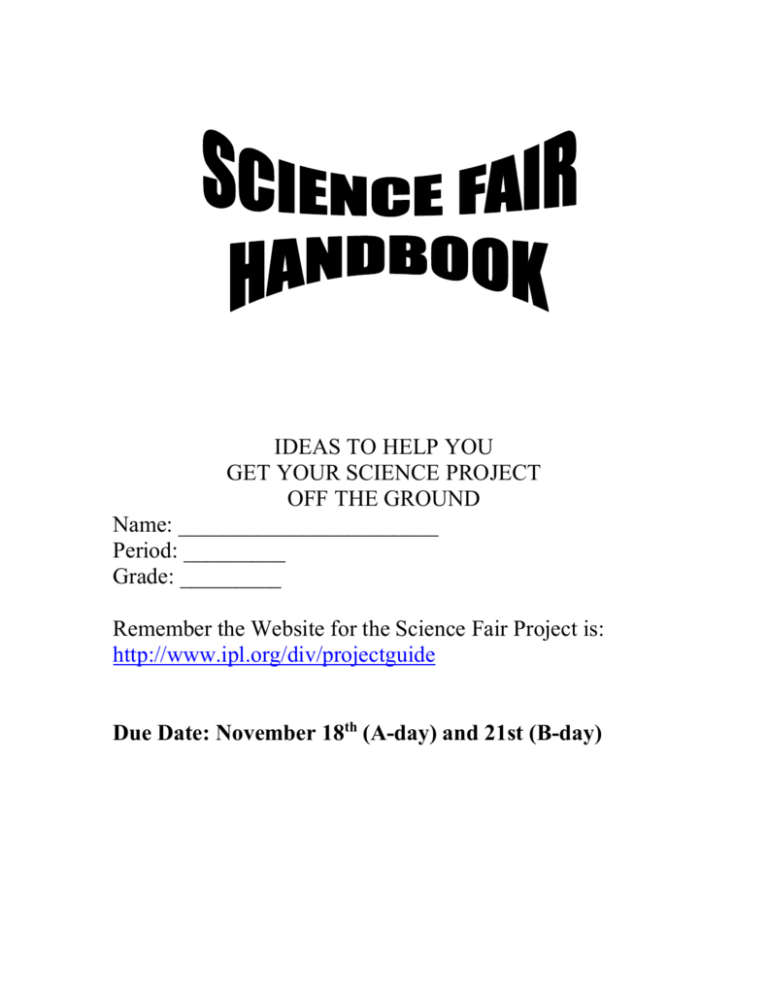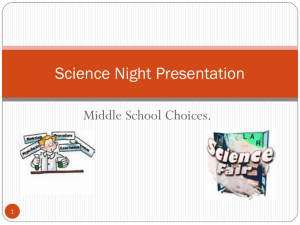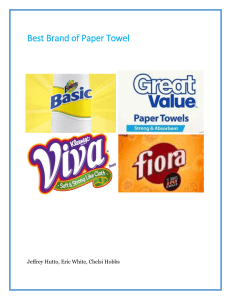ideas to help you
advertisement

IDEAS TO HELP YOU GET YOUR SCIENCE PROJECT OFF THE GROUND Name: _______________________ Period: _________ Grade: _________ Remember the Website for the Science Fair Project is: http://www.ipl.org/div/projectguide Due Date: November 18th (A-day) and 21st (B-day) The Scientific Method Science Fair projects involve discovering new information through the use of the scientific method. The scientific method is a series of steps used to answer a question or solve a problem. 1. Recognize the Problem: The problem-solving process generally begins when you recognize a problem or ask a question 2. Form a Hypothesis: After reading, research, the scientist makes an educated guess about what the answer to the problem will be. This educated guess is called a hypothesis. 3. Test your Hypothesis: Set up an investigation to test the hypothesis Materials: A complete list of materials needed Procedures: A step-by-step description of the investigation Identify a Control group Identify the Independent Variable Identify the Dependent Variable Identify Constants Perform several trials to get firm results Carefully record measurements and other data 4. Analyze your Data: Organize your data on graphs, charts, and tables 5. Results: State the findings of the experiment based upon the data observed and carefully analyzed 6. Conclusions: A statement should be made on whether or not the results supported the hypothesis. Describe problems that might have affected the results. Any other findings or discoveries should be included If you need more information on the Scientific Method study Chapter 1 from your textbook or visit the website www.ipl.org/div/projectguide and click on Scientific method. PROJECT CONTENTS The following areas should be addressed within the context of a science fair project: Title Problem Statement Background Information Hypothesis Materials Procedures Control Variables: Independent Variable Dependent Variable Constants Number of Trials Data Results Conclusions Applications Abstract Bibliography Project Components Title The project title should give information regarding the topic being studied. A good title should be both creative and clear, incorporating adequate scientific terminology. It may consist of the actual problem statement, in which case it should be in the form of a question. Poor title: Paper Towels (too general) Corrected title: The Absorbency Power of various Paper Towels Problem Statement as Title: Which brand of paper towel is the most absorbent, Bounty,Viva, or Publix? Problem Statement A good investigation consists of a problem that can be answered only by experimenting. This statement is always written in the form of a question, and directs the investigation. It may be used as the title. Good problem statements convey a mental image of how the question may be investigated. Poor problem statement: Which paper towel works the best? (unclear) Corrected problem statement: Which brand of paper towel is the most absorbent, Bounty, Viva, or Publix? Projects Ideas (If you do not have any) Visit the Website http://www.ipl.org/div/projectguide and click on “Choosing a Topic” Background Information This is a research report concerning your problem. Use any reference books (encyclopedia, dictionary, library book, internet, etc) this research will serve to help the student understand the topic and form a hypothesis. Hypothesis The hypothesis consists of a statement regarding the investigator’s “guess” about what the outcome of the experiment will be. The hypothesis is based upon the background information that was gathered. After getting information about your topic you should make a guess about what you think the answer to your question may be. Use the form: If…………….., then……………will………….. For example: If the absorbency power of three different brands of paper towels is compared, then Bounty will be the most absorbent. If the temperature of a gas is increased, then the volume of the gas will increase. If plants are fertilized more, then they will grow taller. Materials The materials should be listed in a column. They do not get numbers Include what, how much, and what kinds of materials you used. Keep in mind quantities are important. Be sure to use only metric units. Good Listing Poor Listing 5 -15x15 cm. sq. each of: Paper Towels Bounty, Viva, Publix, paper towels. 250 ml graduated beaker Measuring cup 750 ml water 20 C Water 1 – 20 x 20 cm. sq cake pan Container Celsius Thermometer Thermometer Clock with a second hand Clock Procedure They should be listed step-by-step and get numbers They should begin with an action verb. There should always be a number of trials (at least three) Your step-by-step directions are like a recipe. Anyone who reads them will be able to duplicate your investigation and get the same results. Example: Which brand of paper towel is the most absorbent Bounty, Viva, or Publix? Step-by-Step Directions 1. Cut 5 – 15x 15 cm. sq. from each brand of paper towels 2. Label each cut piece with brand name 3. Pour 50 ml. Of 20 C water into 20x20 cm. sq. pan 4. Place 1 square of Bounty paper towel into water and pan 5. Leave for 30 seconds 6. Remove paper towel 7. Measure water remaining in pan and record 8. Dry the cake pan 9. Repeat steps 4-8 for each brand of paper towel 10. Repeat entire process twice more for each brand of paper towel Control A standard with which to compare the results. Example: If you always buy Bounty, use Bounty as the control and compare its absorbency power with Viva and Publix. If you think that when the temperature of a gas is increased its volume increases as well, use the volume of the gas at room temperature as the control and compare this to the gas volume when temperature is increased. If you think that plants that are fertilized grow taller, use as a control group plants that are not fertilized. Independent Variable Variable that is changed (what you change on purpose in an investigation, change only one variable to make sure that only the factor you changed is what caused the results) Example: Brands of paper towels Dependent Variable Factor being observed or measured Example: Amount of water that is absorbed by each paper towel Constants Factors that stay the same Size of paper towel Amount of water poured on each towel Temperature of the water used Container towels are placed in Method of pouring Number of Trials Conducting an experiment once is called a trial. Repeating an experiment several times is making multiple trials. You should repeat your experiment at least three times if you can do it ten times or more even better. Conducting multiples trials is a good idea because a scientist might make a mistake during an experiment. Or the outcome might be a little bit different each time. Then the results may be averaged. Multiples trials help strengthen the support or lack the support for the theory. Remember you are not allowed to do projects with human subjects, if you are doing a survey like project you need to have at least 50 samples (people you did the experiment with) Data All information that is collected should be presented in an easy-to-understand manner. The data collected needs to be quantifiable (measurable) All measurements in your investigation must be made in metrics. Volume: milliliter(ml) liter (L) Length: millimeter (mm) Centimeter (cm) Mass: milligram (mg) Centigram (cg) Gram (g) Kilogram (kg) 1000ml=1L 10 mm=1 cm 100 cm= 1m 10 mg=1cg 100 cg=1g 1000 g=1kg Data display: Data should be displayed in some type of organized fashion such as tables or graphs which further illustrate the observations you made and the data you collected. Tables: Data is grouped based upon trials and variables factors. Example of a table: (Absorbency data of three different paper towels products- the amount of an original 50 ml of liquid not absorbed by the paper towels) Water remaining (ml) Trial 1 2 3 4 5 Average Bounty 33 32 32 33 32 32.4 Viva 29 28 30 29 29 29 Publix 40 39 40 39 40 39.6 Average Water Absorbed by each Paper Towel Brand of Water Absorbed (ml) Paper Towel Viva 21 Bounty 17.6 Publix 10.4 Graphs There are two main types of graphs Bar Graph and Line Graph. A Bar Graph is used to display data that does not occur in a continuous manner. A Line Graph is used to display data that occurs in a continuous manner. Making a Graph Title: The Title is a short description of the data being displayed. Example: Water Absorbency of three different paper towels Horizontal Axis: The Independent Variable (what you changed on purpose) is displayed on the horizontal axis. Example: Brands of Paper Towel Vertical Axis: The Dependent Variable (what happened as a result of what you changed) Example: Amount of water absorbed (ml) If you need help creating a graph go to www.fl6.msscience.com Click on Student Center Click on Create a Graph If this is your first time creating a graph click on Create a Graph Classic ANALYSIS Most students will collect a great deal of data during their projects. Graphing every single point of data may not be feasible nor useful. The key to good analysis is to reduce a large amount of data to a manageable amount that means something. The use of statistical analysis is an important step in the project. Using measures of central tendency such as mean, median, and mode will help the student better understand the relationship of the different data groups and is easier to graph. This commonly used by most students. Results The investigator should state the findings of the experiment based upon the data that has been observed and carefully analyzed. Preliminary data interpretation may be needed at this point. Example: According to the data, Viva absorbed the most water, followed by Bounty. The paper towel that absorbed the lest amount of water was Publix. After 5 trials each, this is the average amount of water remaining in the pan for each paper towel. Viva Bounty Publix 29 ml 32.4 ml 39.6 ml The amount of water remaining in pan was subtracted from the original amount of water in this case 50 ml to calculate the amount of water absorbed. Water Absorbed Viva Bounty Publix 21 ml 17.6 ml 10.4 ml Conclusions Your conclusions should include: 1. Statement of support on non-support of the original hypothesis. (The data collected did support, or did not support my hypothesis) Did you get the results you expected to get? If not, how were the results different? 2. Description of any problems or unusual events that occurred during your investigation. Were there any unexpected problems or occurrences that may have affected the results of your investigation? 3. What you would do differently next time. Do you think you collected sufficient data? Were there enough trials? Samples? 4. Revised hypothesis (if data did not support your original hypothesis) Do I need to revise my original hypothesis? (If you write a revised hypothesis, DO NOT use it to replace your original hypothesis for this project!) Example: The data collected does not support the original hypothesis. Bounty did not absorb the most, but the difference in the absorbency power of Bounty and Viva is not that evident. I noticed that Viva is thicker than Bounty that is probably why Viva has a greater absorbency power. I think that I performed enough trials but not enough samples, next time I would like to perform the same experiment but having a greater number of samples to make sure that Viva is the one that absorbs the most. Since my original hypothesis was not supported buy my data I need to revise my hypothesis, so if the absorbency power of different types of paper towels is compare then Viva will absorb the most. Applications The investigator should make a statement indicating why the research was important or relevant to real life situations. Example: I would apply what I learned, in the following way: When I need to absorb more water I would use the paper towel that absorbs the most water which is in this case Viva. This does not mean that I always have to buy Viva, because all brands of paper towel work but they all have a different power of absorbency and I think is good to know which one is best. Abstract This is a short synopsis of the entire project. It must include purpose, hypothesis, procedure, results, a statement on whether or not the results supported your hypothesis, and what would you do to improve this study. Abstracts are limited to no more than 250 words in the District, State, and International Science Fairs. This is usually the first item the judges read after the title. Example: ABSTRACT The purpose of this project is to ______________________________________ ________________________________________________________________________ ________________________________________________________________________ _______________________________. It is hypothesized that ___________________ _______________________________________________________________________. I followed the following procedure: (# of steps depending on your procedures, and write sentences on past tense Example: First, I cut five 15 by 15 cm. sq …) First, __________________________________________________________________ ____________________________________________________. Second, ________________________________________________________________ ____________________________________________________. Third,__________________________________________________________________ ____________________________________________________. Fourth,_________________________________________________________________ _____________________________________________________. Fifth, __________________________________________________________________ ____________________________________________________. Sixth,___________________________________________________________________ ___________________________________________________. The results showed that _____________________________________________ ________________________________________________________________________ ________________________________________________________________________ ____________________________________________________. To conclude, the data did support or did not support my hypothesis. To improve this study, I would _______________________________________ _______________________________________________________________________ _______________________________________________________________. Bibliography DO NOT display bibliography on board. A list of all the books, magazines, encyclopedias, dictionaries, and other sources that were used are included ion this section. The appropriate format should be used. Example: Author’s last name, first name Title of book, publisher, and year published, Where published, pages used. DISPLAY BOARD Title Problem Statement Hypothesis Results Procedures Materials Independent Variable Constants Conclusions Dependent Variable Abstract Control Data Charts and Graphs (Mandatory) Photographs (optional) Data log book(s) and report of background material and literature research and/or project report Applications










